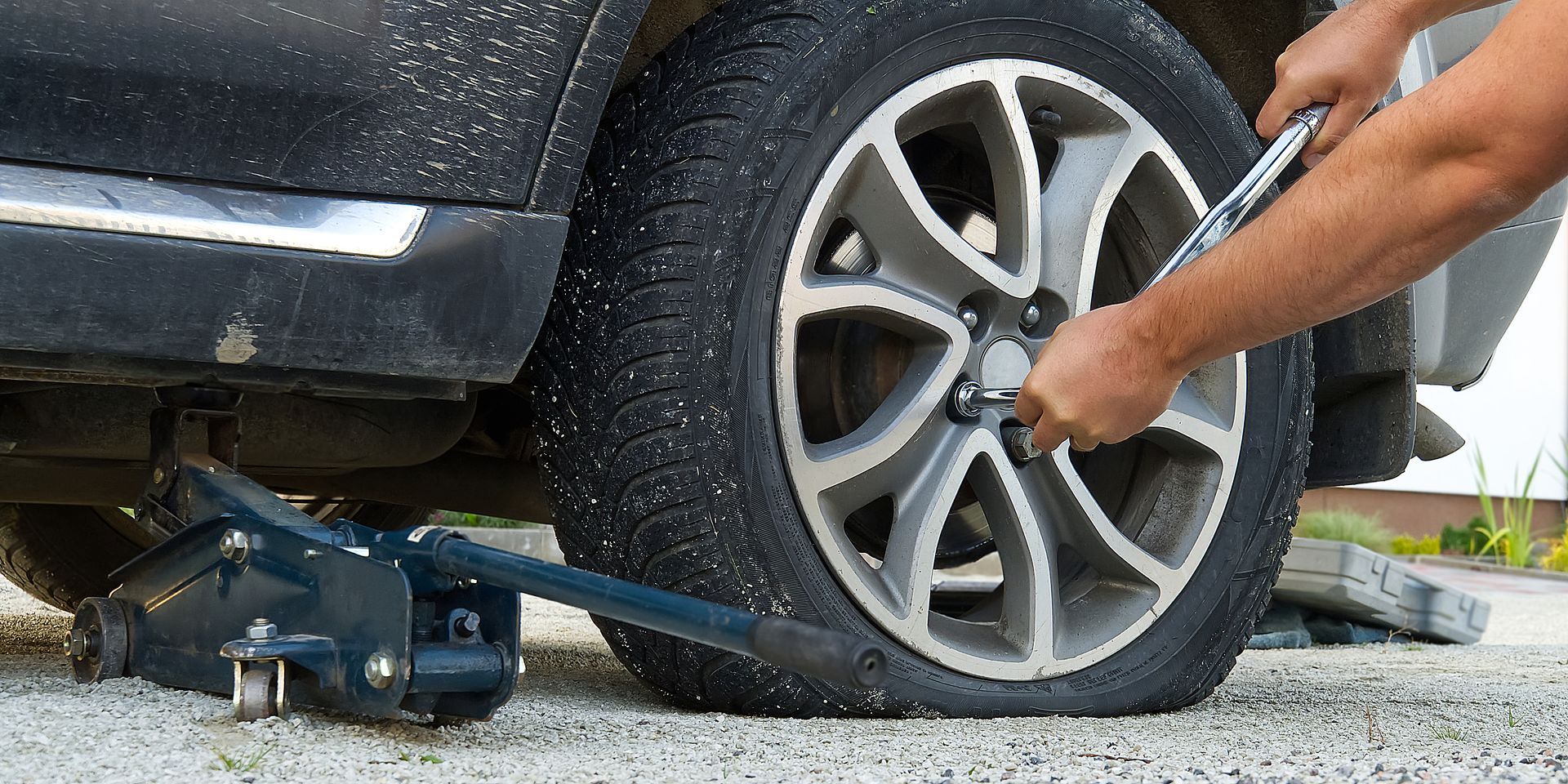Tire repairs are a common solution for minor damages to tires, but there are limitations to how much a tire can be repaired. Understanding these limitations is crucial for making informed decisions and ensuring the safety and longevity of your tires.
Key Takeaways:
- Tire repairs are a viable option for minor damages.
- There are limitations to how much a tire can be repaired.
- Understanding these limitations is important for safety and longevity.
Tire Repair Cost: Evaluating Your Options
When it comes to tire repair, one crucial aspect to consider is the cost. Understanding the factors that influence tire repair cost and conducting a cost-benefit analysis can help you make informed decisions about whether tire repair is the right option for you. Additionally, gaining insight into professional service fees will give you a clearer picture of the overall costs associated with tire repair. Also, if you are in the Phoenix, AZ metro area our team at LugWrench Heroes is happy to provide the options and cost for your tire repair or replacement.
Factors Affecting Tire Repair Cost
Several factors can impact the cost of tire repair. Here are some key considerations:
- Type and Extent of Damage: The severity and type of damage, such as punctures or sidewall damage, can affect the repair cost.
- Tire Size and Brand: The size and brand of your tire can also influence the repair cost, as different tires may require varying repair techniques or materials.
- Location: The location where you choose to get your tire repaired can impact the cost, as labor rates and operating expenses can vary between different service providers.
Cost-Benefit Analysis: Repair vs. Replacement
Before opting for tire repair, it's essential to conduct a cost-benefit analysis to determine if it's more cost-effective compared to tire replacement. Consider the following factors:
- Repair Cost: Assess the cost of repair and compare it to the cost of replacing the tire.
- Tire Condition: Evaluate the overall condition of the tire to determine if it's worth repairing. Consider factors such as tread wear, age, and any previous repairs.
- Longevity: Determine the estimated remaining lifespan of the tire after repair and whether it aligns with your anticipated usage.
- Performance: Consider if the repaired tire will maintain its performance and safety standards.
Understanding Professional Service Fees
When seeking professional tire repair services, it's important to understand the fees associated with the service. Professional service fees can vary depending on various factors, including the reputation and expertise of the service provider. While higher fees may indicate quality service, it's advisable to research and compare prices to ensure you're getting a fair deal on your tire repair.
Understanding Tire Repair Guidelines and Limitations
Tire repair guidelines and limitations play a crucial role in maintaining safety and quality standards. Organizations like the Tire Industry Association (TIA) set these guidelines to ensure that tire repairs are carried out within appropriate boundaries, taking into account the extent of damage and specific repair requirements.
The Role of the Tire Industry Association (TIA)
The Tire Industry Association (TIA) is a leading authority in the tire industry, dedicated to promoting safety and professionalism. TIA establishes tire repair guidelines to ensure that repairs are conducted correctly, adhering to industry best practices. By following TIA guidelines, professionals can provide reliable and effective tire repair services.
Repair Boundaries: Puncture Sizes and Locations
Tire repair guidelines outline specific puncture sizes and locations that can be safely repaired. While small punctures caused by nails or other sharp objects can often be repaired, larger punctures, sidewall damage, or punctures near the tire's shoulder may exceed the repair limits. It's important to understand these boundaries to determine the feasibility of repairing a damaged tire.
When Repair Is Not an Option: Safety Precautions
There are circumstances where tire repair is not a viable option due to safety concerns. For example, if the damage compromises the structural integrity of the tire or if the tire has previously been repaired beyond the recommended limits, it may be necessary to replace the tire for optimal safety. It's crucial to prioritize safety and consider the appropriate precautions when assessing whether a tire can be repaired or needs replacement.
Tire Repair Safety: Ensuring a Secure Ride
Safety is of utmost importance when it comes to tire repair. Properly repaired tires ensure a secure ride and reduce the risk of accidents and tire failure. It is essential to follow appropriate repair techniques, seek professional service, and continuously monitor the repaired tires for any signs of trouble.
Avoiding shortcuts and using proper repair techniques is crucial for maintaining tire repair safety. This includes accurately assessing the extent of the damage, following industry guidelines, and using high-quality materials for repairs. By adhering to these practices, you can ensure that your repaired tires are reliable and secure.
Seeking professional service for tire repairs is highly recommended. Professionals have the expertise and experience to assess the damage accurately and determine the most appropriate repair methods. They also have access to specialized repair tools and equipment, ensuring the repairs are done correctly and according to safety standards.
After the repair process, it is important to continuously monitor the repaired tires for any signs of trouble. Regularly check the tire pressure, tread depth, and overall condition to identify any potential issues. Monitoring the repaired tires will help detect any abnormalities early on and prevent further damage or risks while driving.
How much can a tire be repaired
When it comes to tire repair, understanding the limitations and guidelines is crucial in making informed decisions about the feasibility of repairing a damaged tire. While tire repairs can be a cost-effective solution for minor damages, it's important to know how much a tire can be repaired.
Earlier sections discussed the specific guidelines and boundaries set by organizations like the Tire Industry Association (TIA) regarding puncture sizes, locations, and circumstances where tire repair may not be possible. By considering these limitations, you can assess the extent to which a tire can be repaired.
To illustrate the importance of understanding repair limitations, imagine a scenario where a tire has sustained multiple punctures or has extensive sidewall damage. In such cases, attempting to repair the tire may compromise its structural integrity and safety.
It's essential to consult with a professional tire service provider to assess the damage and determine the repair feasibility. Tire experts have the necessary knowledge and experience to evaluate the condition of the tire and advise on the best course of action.
Repairing a tire beyond its recommended limits can lead to potential safety hazards. It's essential to prioritize safety when considering tire repair. If the damage exceeds the repairable limits, it's crucial to opt for tire replacement instead.
By understanding the extent to which a tire can be repaired, you can make an informed decision about whether to repair or replace a damaged tire, prioritizing safety and longevity.
The Tire Repair Process: A Step-by-Step Approach
In order to successfully repair a tire, it is important to follow a structured step-by-step approach. This section will provide an overview of the tire repair process , outlining the key steps involved in restoring a damaged tire to a safe and functional condition.
Inspection: The Preliminary Step to Assess Damage
The first step in the tire repair process is a thorough inspection to assess the extent of the damage. This involves carefully examining the tire for any signs of punctures, cuts, or sidewall damage. To ensure accuracy, it is recommended to remove the tire from the rim and thoroughly inspect both the outer and inner surfaces. This inspection will help determine whether the tire can be repaired or if it requires replacement. Additionally, it will provide valuable information for selecting the appropriate repair technique.
The Repair Techniques: Patches and Plugs
Once the damage has been assessed, the next step is to choose the appropriate repair technique. There are two commonly used methods for tire repair: patches and plugs. Patches involve applying a rubber patch to the inner surface of the tire, covering the damaged area and creating a seal. Plugs, on the other hand, are inserted into the puncture from the outside of the tire, effectively sealing the hole. The choice between patches and plugs depends on the size and location of the damage, as well as the recommendations of tire repair professionals.
Vulcanization: Creating a Durable Repair
Once the repair technique has been selected and applied, the final step in the tire repair process is vulcanization. Vulcanization involves applying heat and pressure to the repaired area, allowing the patch or plug to bond securely with the tire's rubber. This process creates a durable and long-lasting repair, ensuring that the tire maintains its structural integrity and performance. It is essential to follow the recommended vulcanization procedures and guidelines to achieve optimal results.
By following this step-by-step approach, tire repair professionals can effectively assess damage, choose the appropriate repair technique, and create a durable and safe repair. It is important to note that tire repair should only be performed by trained professionals who have the necessary knowledge and expertise. Attempting to repair a tire without the proper tools or skills can lead to further damage and compromise the safety of the tire.
Tire Repair vs Replacement: Making the Informed Decision
When faced with a damaged tire, it's important to make the right decision between tire repair and replacement. By understanding the criteria for determining repairable vs. non-repairable tires, considering longevity and performance factors, and evaluating the impact of tire age and wear on repairability, you can make an informed choice that ensures the safety and longevity of your tires.
Criteria for Repairable vs. Non-Repairable Tires
Repairability of a tire depends on several criteria. The extent of the damage is one of the primary factors to consider. Minor punctures or cuts in the tread area can often be safely repaired. However, if the damage is extensive, such as sidewall damage or large punctures, it may render the tire non-repairable.
Additionally, the location of the damage plays a crucial role in determining repairability. Repairs to tread areas within the tread wear indicators can be performed, while damages outside of these limits may be deemed non-repairable by industry guidelines.
Longevity and Performance Considerations
Repairing a tire may impact its longevity and performance. While a properly repaired tire can continue to provide reliable performance, it's essential to understand that the repaired area may have slightly different characteristics compared to the original tire. This can affect factors such as tread wear, traction, and stability. However, professional tire repair techniques aim to minimize any adverse effects and ensure safe and satisfactory performance.
Impact of Tire Age and Wear on Repairability
Tire age and wear are important considerations when deciding between repair and replacement. Aging tires may become more prone to damage and may have reduced repairability. Additionally, tires with significant wear or tread depth nearing the legal limit may not be suitable candidates for repair due to decreased structural integrity.
Proper maintenance, regular inspections, and understanding when to retire worn-out tires are crucial in ensuring the safety of your vehicle.
By carefully evaluating the criteria for repairable vs. non-repairable tires, considering the longevity and performance implications of tire repair, and taking into account the impact of tire age and wear, you can confidently make the best decision for your tires. Whether you choose to repair or replace, prioritize safety and consult with a trusted tire professional to ensure the optimal choice for your specific situation.
Distinguishing Between Tire Patching and Plugging
Tire patching and plugging are two common methods used to repair tires, but it is important to understand the differences between them. By understanding the pros and cons of each method, you can make an informed decision about which one is more suitable for your tire repair needs.
Tire patching involves using a patch, typically made of rubber, to cover the puncture or damage on the tire. The patch is applied from the inside of the tire, creating a seal that prevents air from escaping. This method is commonly used for larger punctures or damages that cannot be effectively repaired using other methods.
Tire plugging, on the other hand, involves inserting a plug into the puncture or damage on the tire. The plug is made of rubber or similar materials that can effectively seal the hole. This method is often used for smaller punctures or damages that can be easily accessed from the outside of the tire.
While both tire patching and plugging can be effective in repairing tires, they have their respective advantages and disadvantages. Here is a comparison:
- Tire Patching:
Pros:
- Provides a more permanent and durable repair
- Covers larger punctures and damages
- Does not rely on adhesives or bonding agents
- Tire Patching:
Cons:
- Requires the tire to be dismounted from the wheel for repair
- Can be more time-consuming and labor-intensive
- May require specialized tools and equipment
- Tire Plugging:
Pros:
- Quick and easy repair method
- Can be done without removing the tire from the wheel
- Cost-effective compared to patching
- Tire Plugging:
Cons:
- May not provide as durable or long-lasting repair as patching
- Not suitable for larger punctures or damages
- Relies on adhesives or bonding agents
To determine whether tire patching or plugging is the best option for your tire repair, consider the size and severity of the puncture or damage, the accessibility of the repair area, and your personal preferences. It is always recommended to consult with a professional tire repair service for an expert assessment and to ensure a safe and effective repair.
Conclusion
In conclusion, tire repair is a viable solution for minor damages, but it is essential to understand the limitations and guidelines associated with it. By staying informed and making informed decisions, you can ensure the feasibility of tire repair while prioritizing safety and longevity.
Key Takeaways on Tire Repair Feasibility
When considering tire repair, keep the following key takeaways in mind:
- Minor damages such as punctures within specified sizes and locations can usually be safely repaired.
- Factors such as tire age, wear, and the extent of the damage need to be considered when determining repair feasibility.
- Seeking expert assessment is crucial for accurately evaluating tire damage and determining the best course of action.
The Importance of Expert Assessment for Tire Damage
Expert assessment plays a significant role in determining the feasibility of tire repair. It is advisable to consult a professional who can thoroughly inspect the damage and provide expert advice on whether repair is a safe and viable option. Trusting experts will help you avoid potential risks and ensure optimal tire performance and safety.
Best Practices for Maintaining Tire Health and Safety
While tire repair is a beneficial solution, it's vital to prioritize tire health and safety. Here are some best practices to keep in mind:
- Regularly inspect your tires for signs of damage, such as punctures or tread wear.
- Ensure proper tire inflation to maintain optimal performance and prevent unnecessary damage.
- Follow recommended maintenance schedules and seek professional assistance for tire rotations and alignments.
- Monitor repaired tires for any signs of trouble, such as vibration, bulges, or loss of pressure.
By following these best practices and staying proactive in tire maintenance, you can maximize the lifespan of your tires while ensuring your safety on the road.
FAQ
How much can a tire be repaired?
The extent to which a tire can be repaired depends on the type and extent of the damage. There are guidelines and limitations set by organizations like the Tire Industry Association (TIA) that outline the puncture sizes and locations that can be safely repaired. It's important to consult a professional to assess the feasibility of repairing your tire.
What factors affect tire repair cost?
Several factors can influence the cost of tire repair, including the type and extent of the damage, the tire's size and brand, and the location you choose for the repair. It's essential to consider these factors when evaluating your tire repair options.
Should I repair or replace my tire? How can I determine the cost-effectiveness?
When deciding between tire repair and replacement, it's important to conduct a cost-benefit analysis. Consider the extent of the damage, the tire's age and wear, and the impact on longevity and performance. Comparing the cost of repair to the cost of a new tire will help you determine which option is more cost-effective in the long run.
What are professional service fees for tire repair?
Professional service fees for tire repair can vary depending on the repair shop and the complexity of the damage. It's important to understand these fees to properly assess the cost of repairing your tire. Consulting with repair shops and requesting estimates can help you get a better idea of the fees involved.
What are the guidelines and limitations for tire repair?
The guidelines and limitations for tire repair are set by organizations like the Tire Industry Association (TIA). These guidelines specify the puncture sizes and locations that can be safely repaired. They also outline circumstances where tire repair is not possible, such as sidewall damage or damage near the tire's shoulder.
How can I ensure the safety of tire repairs?
Safety should always be a priority when it comes to tire repairs. Ensuring the safety of tire repairs involves using proper repair techniques, seeking professional service, and ongoing monitoring of the repaired tires for any signs of trouble. Following these practices will help maintain a secure ride and reduce the risk of accidents and tire failure.
What is the tire repair process?
The tire repair process involves several steps. It starts with an inspection to assess the extent of the damage. Once the damage is assessed, the appropriate repair technique, such as patches or plugs, is used to fix the tire. Finally, vulcanization is performed to create a durable and long-lasting repair.
How do I decide between tire repair and replacement?
To decide between tire repair and replacement, consider the criteria for repairable versus non-repairable tires. Factors to consider include the extent of the damage, the tire's age and wear, and the impact on longevity and performance. Consulting with a professional can help you make an informed decision based on these factors.
What is the difference between tire patching and plugging?
Tire patching and plugging are two common repair methods. Patching involves applying a rubber patch to the inner lining of the tire, providing a permanent seal. Plugging, on the other hand, involves inserting a rubber plug into the puncture from the outside of the tire. Both methods have their pros and cons, and the best method depends on the nature of the tire damage.














